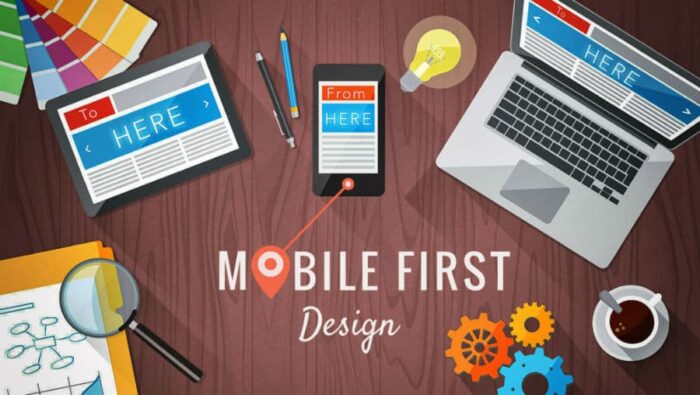Mobile-First Web Design: Why It Matters for Your Business

Take a quick look around you. How many people are using their phones right now? Probably most of them. Businesses that still design websites for desktop first are quietly losing customers every single day. A mobile-first approach fixes that; it ensures your website looks and works perfectly on the devices people use most.
What Is Mobile-First Web Design?
A mobile-first website is designed with smartphones and tablets as the starting point, not an afterthought. Instead of shrinking a desktop site to fit a smaller screen, mobile-first design builds upward: you start small, focus on what matters most, and add layers of detail for larger screens.
You design with your customer’s habits in mind: quick scrolling, thumb-friendly navigation, and instant access to what they came for.
Mobile-first design includes:
- Clean layouts that load fast, even on slower networks.
- Easy-to-tap buttons and forms that don’t frustrate users.
- Streamlined content that highlights what’s most important.
- Responsive frameworks that automatically adjust for any screen size.
In other words, a mobile-first website respects your visitors’ time, and that respect pays off.
Why Mobile-First Design Matters More Than Ever
People Live on Their Phones
According to Statista, over 59% of global website traffic now comes from mobile devices, and this number continues to rise annually. In local markets like Houston, it’s even higher. Whether someone’s searching for “roof repair near me” or “best tacos in Houston,” chances are they’re doing it from a smartphone.
If your website isn’t easy to use on a mobile screen, you’re automatically cutting off half your audience.
Google Prioritizes Mobile in Rankings
Google has officially switched to mobile-first indexing, which means it ranks your website based on how well your mobile version performs. Even if your desktop site looks perfect, Google will penalize you if your mobile site is slow, hard to read, or missing content.
Speed = Conversions
Think about how you browse on your phone. If a site takes more than a few seconds to load, you’re gone. Studies show that 53% of visitors leave a page that takes longer than 3 seconds to load.
A mobile-optimized site loads quickly and keeps visitors engaged.
Better Experience, Better Trust
When visitors can easily find information, read text without zooming, and click buttons without frustration, they stay longer, and they’re more likely to buy, call, or book.
A mobile-first website gives your brand a professional, credible image.
How Mobile-First Design Boosts SEO?
Search engines aim to deliver the best possible experience to users, and mobile usability plays a significant role in achieving this goal. Here’s how mobile-first design directly impacts your SEO:
- Higher Rankings: Google rewards responsive, mobile-friendly websites.
- Lower Bounce Rates: When your site loads fast and works well, visitors stay longer.
- Better User Signals: Time on page, scroll depth, and engagement all improve, which helps SEO.
- Local Search Advantage: Mobile-friendly sites perform better in local results and Google Maps.
If you run a local business in Houston, mobile optimization is no longer optional. It’s the difference between being on page one and being buried in search results.
Elements of a Great Mobile-First Website
A strong mobile-first design is more than just making things smaller. Here’s what successful sites have in common:
1. Prioritized Content
Start with what matters most: your main value, your offer, and your call-to-action. A mobile user shouldn’t scroll endlessly to find your phone number or “Book Now” button.
2. Touch-Friendly Navigation
Menus, forms, and buttons should be easy to tap without zooming in. Clear spacing and minimal options keep users from getting lost.
3. Optimized Images & Videos
Compress visuals to maintain speed without losing quality. Modern formats like WebP and lazy loading techniques keep sites light and fast.
4. Readable Typography
Font size and spacing make or break the mobile experience. Choose legible fonts and use strong contrast for readability in daylight and dark modes.
5. Responsive Layouts
Your design should adapt seamlessly to every screen, from tiny phones to large monitors.
6. Minimal Pop-Ups
Avoid frustrating full-screen pop-ups that block content. Use subtle banners or slide-ins instead.
7. Accessibility for All
Every visitor should be able to navigate easily, including those using assistive tools. Alt text, clear color contrast, and descriptive links make a big difference.
How Mobile-First Design Impacts Business Results?
Businesses that switch to a mobile-first strategy often see improvements almost immediately:
- 30–50% faster load times.
- Lower bounce rates (users stick around longer).
- Higher conversions — whether it’s purchases, form fills, or calls.
- Improved SEO visibility.
- Stronger brand perception.
It’s not just about having a “pretty” site — it’s about performance that drives measurable results.
A Houston-based restaurant, for example, might see more table bookings from mobile searches. A home service provider might get more “Call Now” clicks directly from their site. The ROI speaks for itself.
Common Mistakes Businesses Make
Even well-intentioned redesigns can miss the mark. Here are a few pitfalls to avoid:
- Designing for the desktop first, then shrinking it down.
- Using oversized images that slow down load times.
- Cramming too much content on small screens.
- Forgetting that fingers aren’t as precise as mouse clicks.
- Ignoring how your mobile site looks on real devices.
Mobile-First Design Process: How to Get Started
If you’re ready to make your website truly mobile-friendly, here’s a practical roadmap:
- Audit Your Current Site
- Check how your site performs on different devices. Tools like Google Page Speed Insights can highlight speed and usability issues.
- Identify What Users Need Most
- Focus on their top goals, contact, directions, booking, or shopping. Prioritize those actions above all else.
- Create Mobile Wireframes First
- Design for the smallest screen. Test navigation and content hierarchy early.
- Optimize for Speed
- Compress media, use caching, and reduce code bloat.
- Develop a Fully Responsive Layout
- Use fluid grids and scalable typography that look great on any device.
- Test on Real Devices
- Don’t rely only on simulators. Check usability on different phones and tablets.
- Launch and Monitor
- Track analytics, collect feedback, and continuously refine.
At Houston Texas Website Design, we follow this exact process, combining technical optimization with user-focused design to deliver measurable business growth.
Why Houston Businesses Can’t Ignore Mobile-First Design?
In Houston, where competition is fierce and local SEO matters, mobile-first web design is more than a trend; it’s a necessity.
Your customers are searching while commuting, waiting in line, or relaxing at home. If your site loads slowly or looks broken on their phones, they’ll move on, often to your competitors.
Whether you run a local restaurant, a real estate firm, or an e-commerce business, a mobile-first website ensures that when someone finds you, they stay and take action.
The Future of Web Design Is Mobile (and Beyond)
Mobile-first design isn’t just about smaller screens anymore; it’s about user-first thinking. Your website is no longer a static brochure. It’s your brand’s first handshake and that handshake often happens on a 6-inch screen.
Final Thoughts
Mobile-first web design isn’t just a technical adjustment; it’s a mindset shift. If your business website isn’t optimized for mobile yet, now is the time to act.
Your customers are on mobile; is your website ready for them?
At Houston Texas Website Design, we specialize in mobile-first, high-performance websites that help businesses thrive in today’s fast-moving digital world.
Let’s make your website mobile-ready today.
Contact us now for a free site audit and personalized design strategy.
